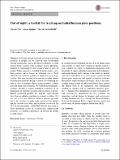Files in this item
Out of sight : a toolkit for tracking occluded human joint positions
Item metadata
| dc.contributor.author | Wu, Chi-Jui | |
| dc.contributor.author | Quigley, Aaron John | |
| dc.contributor.author | Harris-Birtill, David Cameron Christopher | |
| dc.date.accessioned | 2016-12-12T12:30:40Z | |
| dc.date.available | 2016-12-12T12:30:40Z | |
| dc.date.issued | 2017-02 | |
| dc.identifier | 248040132 | |
| dc.identifier | 2d9d2fe7-0c3c-44f7-89f1-13ffd06cd106 | |
| dc.identifier | 85001105653 | |
| dc.identifier | 000393760800012 | |
| dc.identifier.citation | Wu , C-J , Quigley , A J & Harris-Birtill , D C C 2017 , ' Out of sight : a toolkit for tracking occluded human joint positions ' , Personal and Ubiquitous Computing , vol. 21 , no. 1 , pp. 125-135 . https://doi.org/10.1007/s00779-016-0997-6 | en |
| dc.identifier.issn | 1617-4909 | |
| dc.identifier.other | ORCID: /0000-0002-5274-6889/work/34040078 | |
| dc.identifier.other | ORCID: /0000-0002-0740-3668/work/43832023 | |
| dc.identifier.uri | https://hdl.handle.net/10023/9961 | |
| dc.description.abstract | Real-time identification and tracking of the joint positions of people can be achieved with off-the-shelf sensing technologies such as the Microsoft Kinect, or other camera-based systems with computer vision. However, tracking is constrained by the system’s field of view of people. When a person is occluded from the camera view, their position can no longer be followed. Out of Sight addresses the occlusion problem in depth-sensing tracking systems. Our new tracking infrastructure provides human skeleton joint positions during occlusion, by combining the field of view of multiple Kinects using geometric calibration and affine transformation. We verified the technique’s accuracy through a system evaluation consisting of 20 participants in stationary position and in motion, with two Kinects positioned parallel, 45°, and 90° apart. Results show that our skeleton matching is accurate to within 16.1 cm (s.d. = 5.8 cm), which is within a person’s personal space. In a realistic scenario study, groups of two people quickly occlude each other, and occlusion is resolved for 85% of the participants. A RESTful API was developed to allow distributed access of occlusion-free skeleton joint positions. As a further contribution, we provide the system as open source. | |
| dc.format.extent | 11 | |
| dc.format.extent | 924901 | |
| dc.language.iso | eng | |
| dc.relation.ispartof | Personal and Ubiquitous Computing | en |
| dc.subject | Kinect | en |
| dc.subject | Occlusion | en |
| dc.subject | Toolkit | en |
| dc.subject | QA75 Electronic computers. Computer science | en |
| dc.subject | TA Engineering (General). Civil engineering (General) | en |
| dc.subject | DAS | en |
| dc.subject | BDC | en |
| dc.subject | R2C | en |
| dc.subject.lcc | QA75 | en |
| dc.subject.lcc | TA | en |
| dc.title | Out of sight : a toolkit for tracking occluded human joint positions | en |
| dc.type | Journal article | en |
| dc.contributor.institution | University of St Andrews. School of Computer Science | en |
| dc.identifier.doi | https://doi.org/10.1007/s00779-016-0997-6 | |
| dc.description.status | Peer reviewed | en |
This item appears in the following Collection(s)
Items in the St Andrews Research Repository are protected by copyright, with all rights reserved, unless otherwise indicated.

